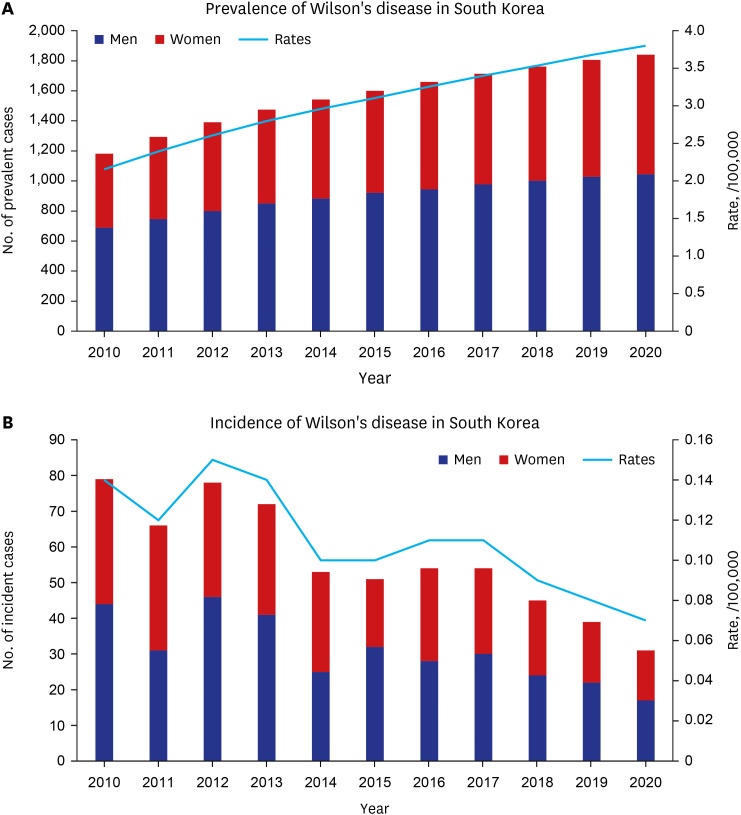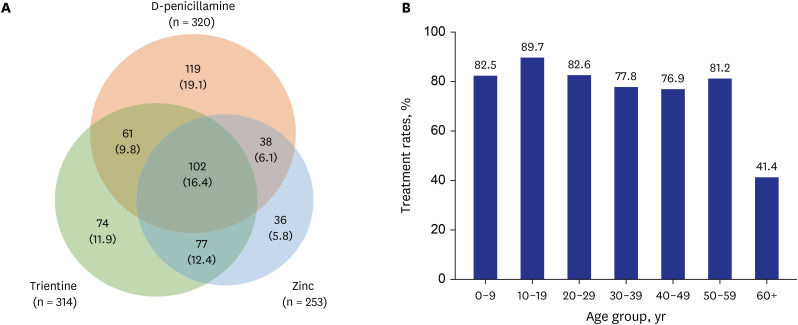J Korean Med Sci.
2024 Apr;39(12):e115. 10.3346/jkms.2024.39.e115.
Prevalence, Incidence, and Treatment Pattern of Wilson’s Disease Using National Health Insurance Data From 2010-2020, Korea
- Affiliations
-
- 1Department of Internal Medicine, Seoul National University College of Medicine, Seoul National University Bundang Hospital, Seongnam, Korea
- 2Department of Cancer Control and Population Health, Graduate School of Cancer Science and Policy, National Cancer Center, Goyang, Korea
- 3Center for Liver and Pancreatobiliary Cancer, Division of Gastroenterology, National Cancer Center, Goyang, Korea
- 4Department of Internal Medicine, Inje University Ilsan Paik Hospital, Goyang, Korea
- KMID: 2554209
- DOI: http://doi.org/10.3346/jkms.2024.39.e115
Abstract
- Background
Wilson’s disease (WD) is an autosomal recessive disorder in which copper (Cu) accumulates in organs, particularly in the liver and central nervous system. This study aimed to investigate the prevalence, incidence, and treatment patterns of WD patients in Korea.
Methods
National Health Insurance System (NHIS) claims data from 2010 to 2020 were analyzed. patients with WD as a primary or additional diagnosis at least once were identified using the International Classification of Diseases (ICD)-10 disease code E83.0 and a record for a registration program for rare intractable diseases in Korea.
Results
The average age- and sex-adjusted prevalence and incidence of WD between 2010 and 2020 were 3.06/100,000 and 0.11/100,000, respectively. The mean age of the patients with newly diagnosed WD was 21.0 ± 15.9 years. Among the 622 WD incident cases during the study period, 19.3% of the patients had liver cirrhosis and 9.2% had received liver transplantation. Psychological and neurological diseases were present in 40.7% and 48.1% of the patients, respectively. Regarding the diagnosis of WD, liver biopsy was performed in only 51.6% of new cases. D-penicillamine, trientine, or zinc were prescribed in 81.5% of the incident cases, and the treatment uptake rates decreased with increasing age.
Conclusion
The prevalence of WD in Korea is 3.06/100,000 and approximately 1,800 patients use medical services annually. A significant proportion of patients are diagnosed at the cirrhotic stage and not treated with Cu-chelating therapeutics, suggesting the need for early diagnosis and adequate treatment to improve prognosis.
Keyword
Figure
Reference
-
1. Terada K, Schilsky ML, Miura N, Sugiyama T. ATP7B (WND) protein. Int J Biochem Cell Biol. 1998; 30(10):1063–1067. PMID: 9785470.2. European Association for Study of Liver. EASL clinical practice guidelines: Wilson’s disease. J Hepatol. 2012; 56(3):671–685. PMID: 22340672.3. Roberts EA, Schilsky ML. American Association for Study of Liver Diseases (AASLD). Diagnosis and treatment of Wilson disease: an update. Hepatology. 2008; 47(6):2089–2111. PMID: 18506894.4. Seo JK. Wilson disease: an update. Korean J Hepatol. 2006; 12(3):333–363. PMID: 16998287.5. Sandahl TD, Laursen TL, Munk DE, Vilstrup H, Weiss KH, Ott P. The prevalence of Wilson’s disease: an update. Hepatology. 2020; 71(2):722–732. PMID: 31449670.6. Kasztelan-Szczerbinska B, Cichoz-Lach H. Wilson’s disease: an update on the diagnostic workup and management. J Clin Med. 2021; 10(21):5097. PMID: 34768617.7. Schilsky ML, Czlonkowska A, Zuin M, Cassiman D, Twardowschy C, Poujois A, et al. Trientine tetrahydrochloride versus penicillamine for maintenance therapy in Wilson disease (CHELATE): a randomised, open-label, non-inferiority, phase 3 trial. Lancet Gastroenterol Hepatol. 2022; 7(12):1092–1102. PMID: 36183738.8. Weiss KH, Thurik F, Gotthardt DN, Schäfer M, Teufel U, Wiegand F, et al. Efficacy and safety of oral chelators in treatment of patients with Wilson disease. Clin Gastroenterol Hepatol. 2013; 11(8):1028–1035.e1-2. PMID: 23542331.9. Stremmel W, Weiskirchen R. Therapeutic strategies in Wilson disease: pathophysiology and mode of action. Ann Transl Med. 2021; 9(8):732. PMID: 33987430.10. Choe EJ, Choi JW, Kang M, Lee YK, Jeon HH, Park BK, et al. A population-based epidemiology of Wilson’s disease in South Korea between 2010 and 2016. Sci Rep. 2020; 10(1):14041. PMID: 32820224.11. Cheol Seong S, Kim YY, Khang YH, Heon Park J, Kang HJ, Lee H, et al. Data resource profile: the National Health Information Database of the National Health Insurance Service in South Korea. Int J Epidemiol. 2017; 46(3):799–800. PMID: 27794523.12. Ministry of the Interior and Safety. Resident registry population statistics. Updated 2022. Accessed January 31, 2023. https://jumin.mois.go.kr/ .13. Kumar V, Singh AP, Wheeler N, Galindo CL, Kim JJ. Safety profile of D-penicillamine: a comprehensive pharmacovigilance analysis by FDA adverse event reporting system. Expert Opin Drug Saf. 2021; 20(11):1443–1450. PMID: 34259127.14. Wijayasiri P, Hayre J, Nicholson ES, Kaye P, Wilkes EA, Evans J, et al. Estimating the clinical prevalence of Wilson’s disease in the UK. JHEP Rep. 2021; 3(5):100329. PMID: 34381985.15. Poujois A, Woimant F, Samson S, Chaine P, Girardot-Tinant N, Tuppin P. Characteristics and prevalence of Wilson’s disease: a 2013 observational population-based study in France. Clin Res Hepatol Gastroenterol. 2018; 42(1):57–63. PMID: 28648494.16. Cheung KS, Seto WK, Fung J, Mak LY, Lai CL, Yuen MF. Epidemiology and natural history of Wilson’s disease in the Chinese: a territory-based study in Hong Kong between 2000 and 2016. World J Gastroenterol. 2017; 23(43):7716–7726. PMID: 29209112.17. O’Brien M, Reilly M, Sweeney B, Walsh C, Hutchinson M. Epidemiology of Wilson’s disease in Ireland. Mov Disord. 2014; 29(12):1567–1568. PMID: 25112974.18. Song MJ, Lee ST, Lee MK, Ji Y, Kim JW, Ki CS. Estimation of carrier frequencies of six autosomal-recessive Mendelian disorders in the Korean population. J Hum Genet. 2012; 57(2):139–144. PMID: 22170460.19. Park HD, Ki CS, Lee SY, Kim JW. Carrier frequency of the R778L, A874V, and N1270S mutations in the ATP7B gene in a Korean population. Clin Genet. 2009; 75(4):405–407. PMID: 19419418.20. Kim GH, Yang JY, Park JY, Lee JJ, Kim JH, Yoo HW. Estimation of Wilson’s disease incidence and carrier frequency in the Korean population by screening ATP7B major mutations in newborn filter papers using the SYBR green intercalator method based on the amplification refractory mutation system. Genet Test. 2008; 12(3):395–399. PMID: 18652531.21. Jang JH, Lee T, Bang S, Kim YE, Cho EH. Carrier frequency of Wilson’s disease in the Korean population: a DNA-based approach. J Hum Genet. 2017; 62(9):815–818. PMID: 28515472.22. Ferenci P, Caca K, Loudianos G, Mieli-Vergani G, Tanner S, Sternlieb I, et al. Diagnosis and phenotypic classification of Wilson disease. Liver Int. 2003; 23(3):139–142. PMID: 12955875.23. Cauza E, Maier-Dobersberger T, Polli C, Kaserer K, Kramer L, Ferenci P. Screening for Wilson’s disease in patients with liver diseases by serum ceruloplasmin. J Hepatol. 1997; 27(2):358–362. PMID: 9288611.24. Nicastro E, Ranucci G, Vajro P, Vegnente A, Iorio R. Re-evaluation of the diagnostic criteria for Wilson disease in children with mild liver disease. Hepatology. 2010; 52(6):1948–1956. PMID: 20967755.
- Full Text Links
- Actions
-
Cited
- CITED
-
- Close
- Share
- Similar articles
-
- Analyzing Treatment Patterns for Neovascular Age-related Macular Degeneration with Expansion of the Korean Health Insurance Policy
- Utilization of health insurance data in an environmental epidemiology
- The Prevalence and Incidence of Parkinson's Disease in South Korea: A 10-Year Nationwide Population: Based Study
- Prevalence of Exudative Age-related Macular Degeneration and Projections of the Cost of Ranibizumab in Korea
- Epidemiology of Moyamoya Disease in Korea: Based on National Health Insurance Service Data



